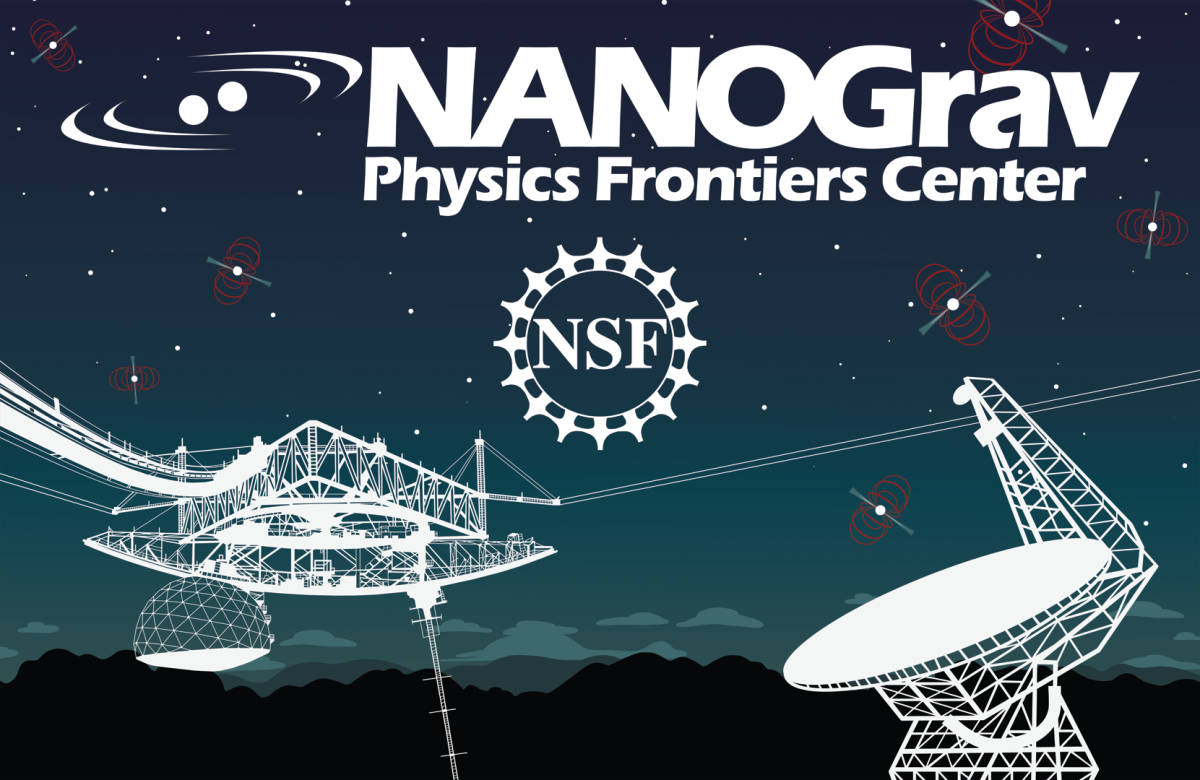
The National Science Foundation (NSF) has renewed its support of the North American Nanohertz Observatory for Gravitational Waves (NANOGrav) with a $17 million grant over 5 years to operate the NANOGrav Physics Frontiers Center (PFC). The NANOGrav PFC will address a transformational challenge in astrophysics: the detection and characterization of low-frequency gravitational waves. The most promising sources of low-frequency gravitational waves are supermassive binary black holes that form via the mergers of massive galaxies. Additional low-frequency gravitational-wave sources include cosmic strings, inflation, and other early universe processes.
Our low-frequency gravitational-wave detectors are millisecond pulsars—rapidly spinning, superdense remains of massive stars that have exploded as supernovas. These ultra-stable stars are nature’s most precise celestial clocks, appearing to “tick” every time their beamed emissions sweep past the Earth, like the beacon on a lighthouse. Gravitational waves may be detected in the small but perceptible fluctuations—a few tens of nanoseconds over ten or more years—they cause in the measured arrival times at Earth of radio pulses from these millisecond pulsars.
“The NANOGrav PFC has made significant progress over the last five years, remaining at the frontier of fundamental physics research,” said Jim Shank, the program director for NSF’s PFC program. “The center now seems close to making a breakthrough discovery in gravitational waves and the way we perceive the universe.”
NANOGrav was founded in 2007 and at the time consisted of 17 members in the United States and Canada. Owing to support from the National Science foundation in the form of a PIRE (Partnerships for International Research and Education) award in 2010, and a PFC in 2015, NANOGrav has grown tremendously. It is now a highly-distributed collaboration with around 200 students and scientists at about 40 institutions around the world. Over the past few years, NANOGrav PFC students, postdocs, and senior personnel have pushed the frontiers of multi-messenger astrophysics, achieved an unprecedented sensitivity to low-frequency gravitational waves, and enabled a transition into astrophysically interesting territory: NANOGrav is now poised to detect low-frequency gravitational waves and use them to study the universe in a completely new way.
Xavier Siemens, a physicist at Oregon State University, is the Principal Investigator (PI) for the project and will serve as Co-Director of the Center. Maura McLaughlin, an astronomer at West Virginia University and Co-Investigator of the project, will also serve as Co-Director.
NSF currently supports ten other PFCs, which range in research areas from theoretical biological physics and the physics of living cells to quantum information and nuclear astrophysics. By bringing together astronomers and physicists from across the United States and Canada to search for the telltale signature of gravitational waves buried in the incredibly steady ticking of distant pulsars, the NANOGrav PFC will advance the mission to “foster research at the intellectual frontiers of physics” and to “enable transformational advances in the most promising research areas.”
“We may already have seen the first hints of a gravitational-wave signal,” said Siemens. “This Center will ensure that researchers have the resources necessary to explore one of the most exciting frontiers in all of physics and astronomy.”
NANOGrav’s five-year program will make use of the unique capabilities and sensitivity of the Green Bank Telescope (GBT) in Green Bank, West Virginia. The GBT is located in the National Radio Quiet Zone, which protects the incredibly sensitive telescope from unwanted radio interference, enabling it to study pulsars and other astronomical objects. It also uses data from the Very Large Array (VLA) in New Mexico and the Canadian Hydrogen Intensity Mapping Experiment (CHIME) in Canada. In addition, NANOGrav will use legacy Arecibo Observatory data which will anchor combined future data sets, and greatly increase our sensitivity. The GBT, VLA, and Arecibo are all funded by the National Science Foundation. NANOGrav is also a member of the International Pulsar Timing Array (IPTA) collaboration, which aims to combine data from telescopes in North America, Europe, South Africa, India, and China to form the most sensitive pulsar timing dataset in the world.
NANOGrav’s ambitious science goals are accompanied by a comprehensive education and outreach program. McLaughlin explains that “the NANOGrav PFC involves students at all levels in our project. We aim to increase the involvement of high-school and undergraduate students in our project, specifically those who are traditionally under-presented in physics and astronomy, through innovative outreach and education programs.”
Related Articles
- National Science Foundation renews funding to support detection of gravitational waves, led locally | Vanderbilt University
- “Astronomers seek gravitational waves with renewed NSF grant” | Cornell Chronicle
- “NSF Grant Renewal Advances Astronomical Research at Lafayette” | Lafayette University
- “Astrophysicist Receives Share of Five-Year, $17 Million Grant” | Texas Tech Today
- “Oregon State leading $17M effort to understand universe via low-frequency gravitational waves” | Life at OSU
- “Physics Professor Partially Funded by National Science Foundation Grant for NANOGrav” | Widener University
- “The Future of the Search for a Gravitational-Wave Background” | AAS Nova
- “NSF Funds NANOGrav Physics Frontiers Center” | Eureka Scientific
- “West Virginia University Advances Collaborative Research as NSF Funds NANOGrav Physics Frontiers Center” | Center for Gravitational Waves and Cosmology, WVU